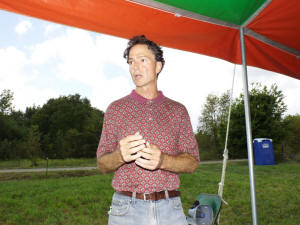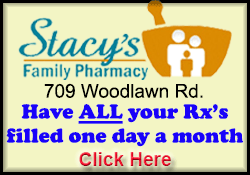|
 Barbara Barcal - All Star Trading Barbara Barcal - All Star Trading
Among the many speakers for the morning-long event was Barbara
Barcal of All Star Trading. Barcal’s firm works with organic
producers to market their products and spoke about imports and
exports of organic and non-GMO grains, and pricing for
organically grown products.
Barcal said that the import of organic products was of concern
for her. She noted that demand is growing for organic products,
and the majority of those products are being imported from
foreign countries because there are not enough U. S. producers
to meet the demand.
Barcal said the demand for organic chicken and eggs is on a very
steady rise. To produce these products, these birds need to be
fed organic products. She said corn, to her understanding was a
major component of poultry feeds.
She noted that in 2012, she paid $16.25 per bushel for organic
corn. (as a point of reference; cash corn on October 9th, 2012
was selling at $7.29-$7.39
http://archives.lincolndailynews.com
/2012/Oct/10/News/
IGPCE101012_GP.shtml ) Barcal said she noted to many
producers that year, that the extremely high price for corn
could not continue because livestock producers could not afford
to pay that kind of price.

She was right about this prediction. Currently, organic corn is
at $8.00 per bushel, according to Barcal, which is still a
premium compared to the cash price for conventionally grown corn
at $3.00 - $3.09/bushel (
http://archives.lincolndailynews.com
/2016/Sep/16/NEWS/IGPCEMEGA_091616.shtml ).
Barcal said even though this is less than 50 percent of the 2012
price, producers are pleased with this price, and they are
making money.
So, what are the concerns? Imports.
Barcal said in 2012 there were no imports of organic corn.
In 2013, the U.S. imported 918 bushels Romanian corn at
$15.25/bu.
In 2014, 29,000 metric tons at $10.21/bu.
In 2015, Romanian imports totaled 14,800 metric tons at
$8.69/bu.
From January to June of 2016, Romanian corn imports total more
than 55,928 metric tons, an increase of more than 200 percent
over the past year.
She added that other foreign countries such as Argentina and
Turkey are also getting on the organic bandwagon, along with the
Netherlands that is just getting into the market.
Barcal said there is not enough corn being grown organically,
though it has great market potential.
Additionally, there is a U.S. demand for grain products that are
not genetically modified, and everything coming in from Europe
is non-GMO, which is to our disadvantage. She noted she had a
buyer contact her looking for Illinois-grown, non-GMO corn, and
she assured him, there was none to be found. She ended saying
this is a concern and one that needs to be addressed locally in
conversations farmer-to-farmer, to encourage greater production
of non-GMO products.
John Steven Bianucci - Iroquois Valley Farms

Next on the agenda was John Steven Bianucci of Iroquois Valley
Farms. Bianucci explained the farm started as a single family
farm, but has grown through its mission to more than 30 farms in
eight states.

Bianucci said the goal is to assist farmers during the
transition years from conventional to organic production. The
firm also works with young farmers and prospective farmers in
assisting them to gain access to farm ground. They also work
with at risk farms to help them regain their financial
stability, to become self-sufficient and profitable through a
buy and sell back program.
In this program, Bianucci said Iroquois Valley would purchase a
farm, and lease it back to the farmer for seven years. At the
end of that time, the producer has the option to buy back the
farm land, or they can continue with the lease program. The farm
in question will be transitioned to an organic and
environmentally aware farm, and will work within the vision of
Iroquois Valley, to use farming practices that protect the
environment and offer safe, healthy alternatives to conventional
food production.
Bianucci said that the firm works with grain crops, alternative
crops, dairy and other livestock, as well as vegetable farms.
When Bianucci finished, Bishop suggested everyone fill their
plates with food provided by Bean Sprouts, a soon to be opened
café/restaurant in Lincoln where the goal will be to offer as
many “farm-to-table” dishes as possible.

When everyone had their meal, the day continued with Bill
Davison speaking during the ‘working lunch.'
Bill Davison – University of Illinois – The Grand Prairie
Grain Guild
Davison founded the Grand Prairie Grain Guild, which is now in
its second year. He said the mission of the Guild was to build
regional grain markets with value-added grains. He said that the
goal is to use the crops that are already being produced in
scale, and being transported to markets in Chicago and other
market locations, as the infrastructure for transporting other
products.
As that system is established, the Grain Guild will add fruits
and vegetables to that transportation system, making it easier
and more affordable to ship Illinois-grown products to the
locations where the demand exists.

[to top of second column] |

He also spoke about a workshop that would be held at the
University of Illinois, where the topic will be on building the
regional system. He said the issues would be working with
regional crop production, toward a harvest with lower input. He
said organic or not, if a farmer is going to produce in a low
input system, different crops need to exist than what we have
today, including corn, soybeans, other legumes, and other grains
such as buckwheat.
Some of the research being done includes working with crops not
typically found in Illinois. Such products include a variety of
wheat including buckwheat, and also grains such as open-pollinated
corn. He said that he had been told that working with crops such as
this cannot work in Illinois, but he said he’s working with farmers
who are already doing it, so apparently they didn’t know it couldn’t
be done.
Davison mentioned, in particular, a farm in Iroquois County that is
growing a six crop rotation, including winter wheat. He said this
farm of 2,500 acres produced 55,000 bushels of organic grain.
Davison said with wheat this farm is growing, edible wheat flour is
being produced and sold to markets in Chicago.
He also talked about the stone mills that are being established. He
said the goal was to move consumers toward a whole wheat milled
flour, but right now, the consumer is accustomed to, and desires
white flour, so mills are being established with sifters that will
refine the flour to the specifications that the commercial bakers
want.
He said that the flour formulation would adjust annually, and bakers
will be educated on the newer, better whole grain product, and will
adjust their recipes accordingly until eventually, they are working
with a pure whole grain product.
He concluded that what is needed now, is a demand for the organic
flour and other products at institutional levels such as schools and
hospitals. He said when those markets are established, there will be
supply available.
Before introducing the final speaker, Bishop noted that transporting
small farm products can be a very costly challenge for producers. He
said Amtrak is now working with a pilot program generating from the
Champaign area, transporting small quantities to Chicago. He
explained that cheeses are being shipped via Amtrak in special
coolers. The producers take the coolers to the Amtrak; they are
delivered to buyers in Chicago, emptied, and returned to the shipper
to use again.

Joe Bybee – Illinois Department of Agriculture – The Illinois
Nutrient Loss Reduction Strategy
Joe Bybee with the Illinois Department of Agriculture made some
quick opening observations. He said what is needed in Illinois is a
“Best Practices” in preserving Illinois soils and protecting
Illinois waterways. He said organic farmers have a head start on
this best practice because they are already mindful of the soil and
waters in their style of farming.
He also noted that there are 23 million acres of tillable soils in
Illinois that are producing two plants. The Nutrient Loss Reduction
Strategy includes expanding those crop varieties to include growing
plants that are good for the soil and will preserve the soil.
He said that the work of the INLRS is recorded on the Illinois
Environmental Protection Agency website. He said the meetings
minutes of the INLRS are regularly posted and permit the reader to
understand the direction in which the “big ship” is going.
The long-term goal of the INLRS is to reduce nitrate and phosphate
loss by 45 percent. Bybee explained that the top two-thirds of the
state are utilizing tile drainage on the majority of their acres. He
said that the INLRS knows that is the location that is producing the
most loss of nitrates from the soils and into the waterways.
Additional challenges come in keeping the soil in place. This is
going to mean better erosion control on sloping lands as well as
lands where there is no tile drainage, and soil is moving with water
on the surface.
He said that one of the bigger answers to the nutrient loss issues
is going to be found in cover crops. He said that everyone is
talking about cover crops and how useful they are, but driving from
northern Illinois to Central Illinois, one sees very few cover
crops.
The bottom line he said is that conservationists are “all in” but
producers are not yet there. The work of the INLRS will include
bringing the producers online with these conservation practices,
including cover crops.
He walked through the various state projects that are ongoing
through the Soil and Water Conservation programs that will bring
greater knowledge to producers of the methods and means to make a
significant impact on reducing nutrient losses into our waterways.
As Bybee finished up, Bishop asked what in his opinion the best ways
to reduce nutrient loss. Bybee said to utilize living plants in
cover crops, no-till farming, crop rotation, and enroll in the CRP
set-aside program through the USDA. He also noted that side-dressing
nitrogen in the spring when crops are up instead of pre-plant and
winter applications would be a “best practice.”

As the day came to a close, Bishop also added a few comments on the
drainage issues. Bishop explained that the acreage where the field
day was being held was tiled for drainage. He has installed shut off
valves so he can better control the water that is released. He said
looking at a tile system that costs $40,000 to $50,000, the valves
can be installed for about $1,000, a small cost compared to the
whole system and a very small cost to protect the environment.
Bybee added one final comment. In opposition to the federal level
Waters of the U.S. (WOTUS) plans that looking to establish
regulations that force producers to comply; the Illinois program is
being developed as a voluntary program.
With the day running long, Bishop called the meeting to an end, but
invited guests to stay and interact as long as they wanted.
[Nila Smith] |